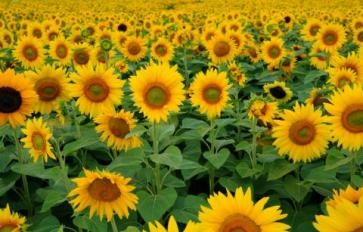
About an hour drive down the Mediterranean coast from Genoa Italy, and 100 meters (330 feet) out to sea, you will find yourself floating above an array of growing produce: this is Nemo’s Garden. Six to 10 meters (20-33 feet) below the ocean’s surface there is an array of fruits, vegetables, and herbs growing in garden beds that look remarkably like jellyfish. Here we find something that could mean a new chapter in agriculture.
In 2012, Sergio Gamberini, the president of the ocean reef group, found himself inspired by the idea of creating an intersection between two of his passions: diving and gardening. Since that time his team has been developing underwater biospheres that utilize the properties of the shallow ocean to grow food in a stable environment. Since their inception, these subaquatic gardens have evolved from a self-contained bed of basil with about fifty cubic liters of volume to five biospheres coming in at about two-thousand liters of volume with 26 hydroponic seed beds a piece. The project was dubbed Nemo’s Garden.
Why Would You Put a Farm Underwater?
Well, putting a farm underwater actually solves quite a few issues that surround agriculture of the terrestrial variety. Primarily, because of the thermal insulation of the medium of the ocean, the biospheres do a particularly good job at automatically maintaining a warm, humid internal environment. The sunlight between 5 and 15 meters (16.4 and 49.2 feet) below the ocean’s surface is adequate to penetrate the water and create an effect similar to traditional greenhouses but quite a bit less susceptible to environmental temperature change. The thinking behind this is that temperatures and environmental factors will become increasingly sporadic as climate change has an increasingly significant impact on weather patterns. Underwater agriculture could provide a very stable balance between temperature and light.
The location of the biomes also makes it quite difficult for parasites and fungi to find their way into the crop. With the exception of the accidental introduction of these blights into the environment by divers (referred to as agrinauts on the Nemo’s Garden website), the contained nature of the curious acrylic domes actually entirely eliminates any need to use destructive herbicides and pesticides to preserve the crop. Though there is ever more awareness around the detrimental nature of industrial farming, the agricultural chemical market is still projected to grow to 308.9 billion dollars by 2025. That amounts to a staggering 43.6% increase in value since 2016. The idea that the streamlining of this technology could change that 2025 outcome is exciting, to say the least.
Finally, and probably most significantly, the temperature difference between the surrounding water and the sunlight heated domes is drastic enough to cause a significant amount of surface evaporation. This works like a distilled alcohol still, with the temperature difference causing evaporation of pure water that then condenses on the inside of the dome and trickles down into a reservoir that supplies the plants with water. Enough water, in fact, to completely supply the plants—maybe even more than enough. As ocean temperatures rise, the rate of evaporation is increasing and causing occasional surpluses of fresh water in the biospheres.
This is exciting because desalination—an increasingly important topic as global availability of fresh water continues to dwindle—has traditionally been a very expensive process. Desalination via distillation, like the process used in the domes, requires an external heat source to cause evaporation. This quickly becomes a very resource intensive task. The other method (desalination via filter, aka, reverse osmosis) is proving to be more efficient, but has yet to become a cost-effective alternative to simply importing water from elsewhere. That being said, free is free, and the dome desalination process eliminates the need to dispose of the byproduct (salt), and only requires pumping to the surface to be usable.
Limitations of Underwater Farming
While these jellyfish farms certainly hold quite a bit of potential, they have a long way to go before they become a realistic and fully self-sustainable resource. The farms, being based on a traditional hydroponic system, do require additional nutrients in order to propagate the plant population and thusly, is not a closed system agriculture solution.
That being said, because of the immense amount of research opportunity created by the existence of these domes, pharmaceutical companies, cosmetic companies, and even Volvo has partnered with Nemo’s Garden. As a result, the farms are yielding a sizeable and growing body of research, one branch of this being into the possibility of utilizing algae as organic fertilizer. As higher temperatures and increased amounts of carbon dioxide in the air and water result in greater possibility for problematic algal blooms, the possibility of utilizing their overproduction in a constructive way could be a sustainable and scalable solution for our changing world.
Of course, the current constraint of the tech and resource heavy construction prevents the creations from being realistically scalable at the moment. In addition to an intensive sensor apparatus including CO2, O2, humidity, air temperature, gyroscopic monitoring, and video monitoring, maintenance technicians must be certified divers. There are 28 thick chains anchoring each dome to the ocean floor; they all require water to start the growing process, albeit a small amount, and they are rather susceptible to harsh storms. Their live sensor data page was actually down for a bit as a result of a severe storm on March 15th damaging the sensor arrays.
The Potential of Underwater Farming
Though there are a number of logistical obstacles between Nemo's Garden and an agricultural revolution, the fact that tomatoes, strawberries, mint, aloe vera, and beans are being grown beneath the ocean's surface inside of these glowing high tech jellyfish certainly captures the imagination. Along with the half ton, aesthetically functional, flower of life sculpture in the center of the ring of gardens, the picture feels otherworldly and inspires philosophical waxing on the future of food and jellyfish. Curiously enough, aquatic life has also become attracted to the structures. According to the Washington post, squid have begun to take shelter on the ocean floor beneath the structures and endangered seahorses have been found to create nurseries in the shadow of the hovering constructions.
The final oddity here which has garnered a significant portion of the interest generated around Nemo’s Garden is the fact that for reasons as of yet unknown, plants are growing better under water. Though the significant levels of available CO2 can partially explain the accelerated rate of growth, an increase in the production of essential oils has yet to be unexplained. In basil, for example, the content of essential oils jumped from 57% to 73% when grown underwater, which is beginning to raise questions around the idea of plant cultivation in pressurized environments. Though it will be some time before we see this method start cropping up elsewhere, these hovering testaments to human ingenuity hint at a hopeful reconsideration of the way that we grow our food.








